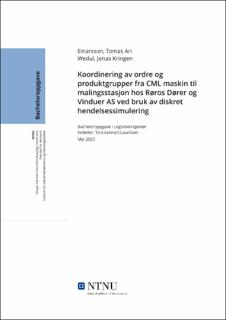| dc.description.abstract | Røros Dører og Vinduer AS (RDV) produserer dører og vinduer fra råvare til ferdig produkt. Oppgaven tar for seg prosessene før produktet skal males, som hovedsakelig er impregnering, sortering og montering av dører og vinduer. En CML høvlemaskin produserer alle karm- og ramme-bitene til vinduene og dørene, som videre blir sendt inn til montering i to ulike avdelinger, ramme/karm/impregnering- og døravdelingen. Etter monteringen er vinduene eller dørene klar for maling.
Når en ordre kommer inn fra kunde blir den plassert på en dagsserie. Siden produktgruppene går gjennom forskjellige prosesser fører det til sprik mellom når produkter fra samme ordre ankommer malingsstasjonen. Det var derfor et ønske fra RDV å undersøke dette og bidra med data som kan bli brukt i kalkylene deres fremover.
For å løse og analysere oppgaven har det blitt benyttet diskret hendelsessimulering i 3D-simuleringsprogrammet FlexSim. Sammen med RDV har det blitt opprettet seks produktgrupper som dekker det meste av produksjonsvolumet. I løpet av prosjektperioden har rådata blitt samlet inn for de prosessene som produktene går gjennom og brukes i tilsvarende prosesser i simuleringsmodellen. Modellen har blitt brukt til å teste produksjonsplaner og finne en plan som gir bedre samling av ordre, og samtidig reduserer variasjon i gjennomløpstiden til produktene. | |
| dc.description.abstract | Røros Dører og Vinduer AS (RDV) produces doors and windows from raw materials. The project includes the processes up until painting, which mainly consists of impregnation of wood, sorting and assembly of doors and windows. A CML wood planer produces all frame- and sill-pieces for the windows and doors. After this they are assembled in two different sections of the factory, which are frame/sill/impregnation of wood- and the door section. Finally, when the windows or doors are assembled, they are ready for painting.
When a purchase order is received from a customer it will be placed in a series, which contains all of the purchase orders for that specific day. Since product groups undergo different processes, the throughput time varies for different products. Because of this, products in the same purchase arrive at different points in time at the paint station. Therefore, RDV wished to further examine this issue, and also collect data which can be used for future calculations.
Discrete event simulation with the 3D-simulationtool, FlexSim, has been utilized to analyze and solve the issue. Together with RDV, six product groups have been made which cover most of their production volume. Through the timespan of the project, raw data has been collected for the processes that the product groups go through, which is then used in the simulation model. The model has been used to test production schedules, and to find a schedule with improved purchase order coordination, while also reducing variation in throughput time of the products. | |
